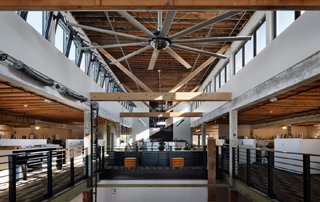|
Subscribe / Renew |
|
|
Contact Us |
|
| ► Subscribe to our Free Weekly Newsletter | |
| home | Welcome, sign in or click here to subscribe. | login |
Environment
| |
 |
February 23, 2012
How we earned LEED platinum without blowing our budget
Rice Fergus Miller

Rice
|
Agrowing number of buildings in the Puget Sound region and beyond are pushing the envelope when it comes to green design.
While these LEED and “living” buildings are raising the bar for performance, efficiency and beauty, many are also setting an example of sustainability with an unsustainable price tag.
For leading-edge green design and construction to break through to the mainstream, it must fit with mainstream construction budgets. Next-generation sustainable development needs to send the message that value and performance don’t have to be sacrificed when staying within a tight budget.
The new office and studio of architecture and interior design firm Rice Fergus Miller offers just that.
In 2009, Rice Fergus Miller purchased a derelict 30,000-square-foot former Sears Automotive Center in downtown Bremerton. Two years and nearly $3.15 million in construction costs later, the renovated commercial building is “deep green” with an energy use index of only 21 — making it the most energy-efficient building in the Pacific Northwest by nearly 50 percent.
As owner, developer and designer, the firm achieved LEED platinum at the market-rate cost of $105 per square foot. Given that the only salvageable part of the building was its raw shell, the numbers are even more surprising.
From start to finish — and continuing through eight months of operation — this building has been a discovery process about how to approach sustainable design and construction in order to achieve the highest performance and value at a low cost.
93 percent reused
Adaptive reuse is not a new concept but it is gaining traction as developers and designers turn an eye to existing buildings. Tapping into the value of, and resources within, existing buildings not only provides an opportunity for sustainable development that honors the history and context of the surrounding community, but in some cases, is the key to the financial viability of commercial projects.
Rice Fergus Miller was able to capitalize on the building’s location, footprint and shell in order to invest in the upfront cost of high-performance, resource-efficient design strategies that reduce the operating cost, and therefore make for faster payback.
When all was said and done, 93 percent of the building was reused. Through selective demolition, Poulsbo contractor Tim Ryan Construction was able to salvage many materials for reuse. The materials included Douglas fir beams that became a feature wall, furring strips that were turned into tables, and mechanical remnants from the former freight elevator that now lift the flywall in the office’s central forum space.
Approximately one-third of the roof was salvaged and used to rebuild a clerestory roof area that provides daylight from top to bottom.
Beyond the checklist
Many projects begin with what is known as a LEED charrette, where sustainable design options are discussed with the goal of generating points in the U.S. Green Building Council’s LEED rating scale, for which platinum is the highest rating.
Often, building owners and developers are asked to validate systems or design paths that may cost more money without a clear understanding of the potential return on investment. This approach breeds the notion that green costs more.
In Rice Fergus Miller’s case, the LEED checklist was set aside. The team decided at the outset to try for the most sustainable project it could imagine within the confines of a finite budget.
What came out of this approach was a set of goals that guided decision-making from that point forward:
• Carry out passive net-zero strategies.
• Rely on local sourcing for products, craftsmen and artisans.
• Quantify the economic bottom line.
• Reduce water usage.
• Build a healthy place to work.
• Use the building as a laboratory to further sustainable design.
Ending up with a project that earned a high LEED point total was simply a byproduct of this approach.
Rice Fergus Miller involved its mechanical engineering partner, Ecotope, early on to co-create an energy model before any design drawings had been drafted. The project team utilized the energy model to drive the design, which has resulted in a reduction in the building’s overall energy use by 78 percent.
Off-the-shelf parts
In the case of this project, translating low-tech systems into high-performance rewards came from creativity, not cash.
For instance, the team opted to super-insulate the building’s existing concrete shell and then create a small, economical, non-central HVAC system from separate off-the-shelf parts. The decision to reach performance goals with this high-low combination of strategies was reached because the solution fits the building, climate, use and budget.
By investing in energy efficiency up front, Ricer Fergus Miller will use energy savings to recoup the cost of its super-insulated skin within a year.
This LEED platinum, market-rate project validates for building owners and developers that considerable energy reduction and overall high performance is achievable within a typical project budget — no sacrifices necessary.
Steve Rice is the managing senior principal of Rice Fergus Miller, a 37-member architecture and interior design firm he founded in Bremerton in 1987.
Other Stories:
- Does a green retrofit make sense for your building?
- LEED platinum house: green from start to finish
- Your projects can still be green, even if LEED doesn't fit
- City expands its goals for green with 2030 District
- Which green certification program is right for you?
- 'Living buildings': What we’ve learned so far
- ‘Living streets’ aren’t just for drivers
- Putting power-hungry data centers on a diet
- Workers prefer their office makeovers green
- Live, work and farm at Ballard's Greenfire



